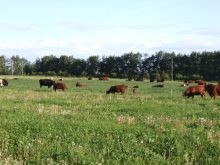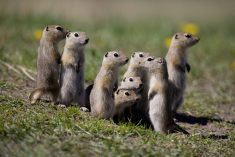It’s no secret to those in the cattle industry that, whether becoming a veterinarian or starting out as a beef producer, a great deal of hard work, long hours and lifelong learning are required. No stranger to these hurdles, Lacey Tillotson of Innisfree, Alta., was up for the challenge.
As young as 11 or 12 years old, Tillotson knew that she wanted to one day become a cow vet. “I wanted to become a veterinarian since I was old enough to understand the meaning of the word,” she says.
Read Also

Body condition, nutrition and vaccination for brood cows
One of the remarkable events of the past century related to ranching has been the genetic evolution of brood cows….
It was a clear choice inspired first by her grandfather and then her mother who had both aspired to practice veterinary medicine but were never able to realize that dream. Her grandfather, instead, settled for managing the Minburn Community Pasture and her mother went on to work as an animal health technician at the local vet clinic.
Veterinary medicine is not the only vision Tillotson shared with previous generations. As a third-generation beef producer, cow-calf production is in her blood.
“Growing up, my family always had cattle, between 80 to 100 cows, and my dad worked off the farm. My mom was working at the vet clinic and did much of the work with the cows at home, so I got a lot of passion for the beef industry and veterinary medicine from her,” she says.
Complementary professions
Tillotson and her husband Tim moved back to take over his family farm in 2017, five years after she started practicing as a large animal veterinarian with the nearby Viking Veterinary Clinic.
When asked if she ever questioned the logistics of running a cow-calf operation along with working full-time as a vet, Tillotson says, “My grandma, on Dad’s side, was the one at home with the cows and so was my mom. That was a real inspiration to me. I grew up seeing the women do it so I never questioned that part. It empowered me and instilled in me that I could go out and work with these animals everyday whether as a vet or on the farm.”
She hopes that she will be a positive example for others wanting to be part of the cattle industry, especially her seven-month-old daughter Samantha.
With Tim working as an agronomist and Tillotson doing vet work, the two of them had to get creative with management practices to fit their busy schedules. Swath grazing followed by a modified bale grazing strategy is one of their key management practices as it reduces the labour required to feed the cows in colder months when daylight is at a premium.
Most importantly, it allows the cattle to receive proper nutrition as well as build organic matter in the soil at the same time. Through careful bale placement, they make sure the bale grazing residue benefits the sandy hilltops that need the added organic matter. When it comes to bale grazing Tillotson believes “waste is not waste if it’s in the right place.”
Calving on pasture is one way the Tillotson’s juggle off- and on-farm work in springtime. An important part of calving on pasture is selecting breeding bulls for their herd with an emphasis on calving ease EPDs. Tillotson says they use a “one strike and you’re out” policy when it comes to calving issues.
“With both of us working full-time we likely aren’t around to check them during the day. Any cow that requires helping calving is going to be a cull which makes for a really strong herd.”
Reduced disease pressure is another advantage to calving on pasture, says Tillotson. They rely on cross-fencing to divide their pastures so that younger calves aren’t being born in an area with the older calves in order to minimize the possibility of a scours outbreak.

Herd health is a top priority, achieved through a good vaccination protocol and regular feed testing. Although the upfront cost to things like vaccinations may seem daunting, with her veterinary experience Tillotson can assure clients that prevention is the best medicine. It’s a standing joke at the Tillotson farm that they always need to cut back on vet costs.
“My retort back is, yeah but your death loss is lower than any other farmers, so you don’t mind,” laughs Tillotson.
Their teamwork approach to ranch management adds a lot of value to their cattle operation. “My knowledge of veterinary medicine and cattle really complements his knowledge on the land and the grazing management as well as the business side of things,” she says.
Not only does Tillotson’s veterinary background contribute to the ranch, her ranch experience is also a huge asset when it comes to her vet work. She is quick to mention that her ranch background goes a long way in building a great rapport with her clients.
“As a veterinarian I really value my connection to my fellow beef producers. I get a lot of enjoyment out of those relationships and being part of their team.”
Continuous learning valuable
Tillotson could not stress enough the need for continuous learning in a rapidly changing beef industry. “You have to be willing to challenge those paradigms and go out there and find information.”
Tillotson and her husband use a multitude of the resources available when it comes to furthering their knowledge. “We love the Working Cows podcast and find it an endless source of information,” Tillotson says. In addition, she credits the book Healthy Land, Happy Families and Profitable Businesses by Dave Pratt as one of their go-tos.
“You really have to be committed to lifelong learning. I truly believe that the most dangerous phrase in the English language is: ‘We’ve always done it that way,’” she says.
While some operations struggle with this mentality when it comes to generational transfer of the farm, Tillotson is quick to point out the great help and mentoring both her and Tim’s parents have provided them.
“Tim’s dad was always very progressive in his grazing management, which was a huge help when it came time for us to take over and learn to stock the pasturelands ourselves.”
That progressive mindset is key to being successful in all aspects of agriculture and something that has been passed down in Tillotson’s case.
“We have had some really good mentors in our family members,” Tillotson says, “and we just hope to carry it into the future with the next generation.”
A true believer in the value of mentorship, Tillotson has embraced the opportunity to participate in the Cattlemen’s Young Leaders program.
“One of the nice things about being part of the CYL program is gaining a broader industry understanding and that’s why I did it. I thought it would complement not only my veterinary career but also the ranch as a whole.”
Through the program, she was matched up with mentor Dr. Troy Drake, a fellow veterinarian and creator of Herdtrax software. Tillotson stresses that complete records are key to understanding your own operation and are one of the most valuable tools for making improvements along with minimizing the worst-case scenario like a disease outbreak. She compares Herdtrax to a “check-engine light” for the herd.

Continuous learning goes hand-in-hand with the constant need for sharing information with those outside the industry. Industry programs, such as Verified Beef Production Plus (VBP+), not only sharpen one’s own management via record-keeping and best practices, but also help immensely when relating our industry to the end consumer, one thing Tillotson is deeply passionate about. She feels these conversations are inherent to the sustainability of the beef industry.
“Consumers are so far removed from the actual production networks that they just don’t understand the positives of beef production, so I think it’s important that we have a consumer-facing label. People need to see the proof; VBP+ checks the boxes for consumers and makes them feel better about the products they’re consuming,” Tillotson says.
Tillotson highly recommends getting involved in industry meetings and attending conferences as a source of credible information.
“Certainly, producers can really benefit from a network of other producers that can inspire you, motivate you, share in your frustrations and ask questions.”
She sees the Beef Cattle Research Council webinars as a great resource for anyone in the beef industry. It’s one source she references often as a beef producer as well as a veterinarian. She also considers Canadian Cattlemen “a great resource.”
“Tim’s dad wrote in with a calving tip and he still has the original Cattlemen that his tip was published in. After 20 years, that issue is still in the office here at the farm, so it just goes to show what a resource the magazine has been over the years.”
Mona Howe, owner of Mo Cattle, raises seedstock and commercial Angus cattle in southeastern Alberta and freelances in her spare time.
















